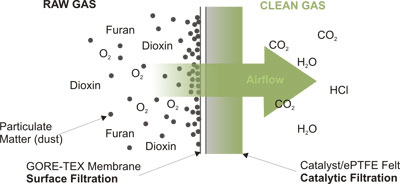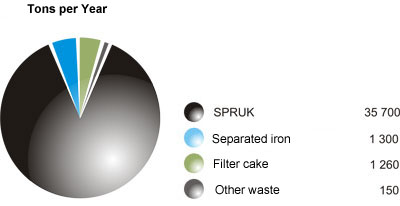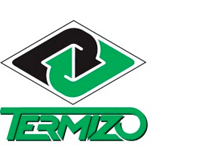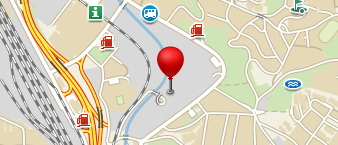Output of materiál flow and emissions
The main outputs are:
1. Purified waste gases, includes description of the „dioxine“ emission
For optimal course of burning and for the decrease of pollutant substances in waste gases systematic technical measures are used, these have been exemplified here.
To date the course of the incineration plant Termizo a.s. has proved that it is capable of properly cleaning waste gases. The quality of cleaned waste gases is measured both by a continual analytical apparatus, and in law abiding terminology authorized by laboratories which specialize in devices for measurement. The apparatus is attached only during the time of measuring in the stack of the incinerator. From the start of operation the incinerator has reached considerably lower levels of emission than the Czech and European limits.
In terms of execution of the graphical comparison, the outstanding cleaning power of the technology is bolder. In particular we need to take note of the very low emission rate of heavy metals thanks to the installation of the wet waste gas scrubber.
The incinerator of municipal waste replaces here the heat that is produced at its neighboring heating plant Teplárna Liberec. It also significantly reduces emissions with main pollutant gases that are let into the air (above all N-oxides and sulfur oxides). These components are especially dangerous in the city region of Liberec.
Dioxines
A well-known question to the media is the much discussed emission question “dioxine“ (PCDD/F) from the incineration plant Termizo a.s. Review of the possible effects it could have on the townspeople of the Liberec region we can see the risk factor. The conclusions of the analysis are, that the impact of emitted substance PCDD/F is from the medical point of view completely fractional. The deciding load of PCDD/F is emitted from other larger sources. (Above all the local furnaces).
Some information from eco-activist organizations are doubtful and shouldn’t be taken into consideration. The issue of cleaning burned gases in modern incinerators are well managed and this is the same for the incineration plant Termizo a.s.
Gore-Tex filter
Lately there has been a meaningful scientific progress in the development of new catalytic methods which eliminate harmful organic substances from waste gases on a filter made from special fabric.
The principle of this method is systematically shown in the picture. We studied on the site two incinerators in Belgium, each of them has a comparable capacity like the incinerator TERMIZO a.s. In one incinerator there these special catalytic fabric filters work for almost 5 years and input value of emission PCDD/F now reach 30-50% of the requirements. These filters were introduced into the operation of our incinerator in the year 2003. The first results affirmed expectations and less than 50% of the limit of 0.1 ng TEQ was reached.

2. Purified processed waters
This water is the product of technological waste water, which occurs during the treatment of waste gases with chemicals (demineralised water, sodium hydroxide) and also in the process of washing. Originated residue is thickened deposit and is later extracted on a filter. The thickened product, otherwise known as a filter cake, is then processed as dangerous waste according to the conditions given by the legislative laws. Cleaned water is drained into public sewage and together with other sludge is then cleaned in the town sewage disposal plant. Reached quality of this water enables discharging straight into the river Nisa but instead of it the water undergoes another turn being released into sewerage.
Cleaned water pass through another sewage disposal plant and then finally the waste water is released into a river with a larger current.
3. Solid waste including solid products used as materials
- A mixture of burnt out slag rising from the boiler and cleaned light ash separated from waste gases. The main portion of solid waste is made up of burnt out slag, rising from its boiler together with cleaned light ash separated from waste gases. This waste does not have dangerous characteristics, but earlier it had to be stored with other waste. In compliance with the regulations of antipollution measures we looked for a way to decrease the quantity of waste produced by this way.To minimize the quantity of produced solid waste a mixture of slag and cleaned light ash was chosen for these reasons:
- It has a favorable constitution, which fits to the building industry.
- Chemical analysis prove a possibility of achieving the legislative limit.
- Burned out scrap metal fits to recycling in smelting works.
Goal directed procreation of engaged purposes concurrently transacted on a variety of levels:
- Technological procreation notably increased the quality of ash matter produced (the improvement of quality in the course of burning and the optimalisation related to technical flow, introduction of outgoing intermediate wash with water).
- Research has shown evidence of utilization in the building industry.
- A certification process on the product went ahead according to the law No. 22/1997 Coll. (technical requirements on products).
- The running of magnetic separation of steel from mixtures of ash matter was successful.
The whole process was concluded by a conferment certificate No. 040-014253 (Technical and Trial Institute of building Prague, extension 0400 Teplice – Technický a zkušební ústav stavební Praha, pobočka 0400 Teplice) for the product marked “Mixture of ash matter for reclamation and the adjustment of landscapes” (SPRUK). This product embodies similar characteristics as poor concrete. After three days this mixture proceeds to set so that it is fit for constructional building banks and fill – view certificate.
Therefore there has been a dramatic fall in waste produced in order to produce new products, as indicated on the following graph.

From the graph it is evident to see that it is possible to achieve the decrease of produced waste by approximately 96%. With the application of this project the yearly usage of recultivated material could roughly reach around 36 000 tons as a replacement for raw building materials. Another 1 300 tons of scrap metal could be possibly recycled at smelting works. This array of original technology meets all priorities of environmental antipollution measures, that is, the maximum quantity of waste (if already came into being) can be benefited from and thus save prime natural resources.
- Filter cakeAnother major kind of waste which is produced is the filter cake coming from the cleaning of gases. This originates in the technology of process water cleaning and contains dangerous components which are parts of waste gases (heavy metals, further sulfur dioxide in the form of sulfites and sulfates). This material exit transfer is commissioned to a company that specializes in the overworking of dangerous waste in such a way so that it can be safely put away in a landfill for dangerous waste. In our particular case this waste goes through a solidification process. Here you can find the average composition of the filter cake. It has a dampness of roughly around 70% and besides that it can be utilized to produce zinc, as in Switzerland or as in Germany.
- Other wasteDuring periodic cleaning of the boilers and space consequential to the incineration boiler waste like unrefined light ash occurs during the regular dead plate facility breaks. This light ash namely isn’t purified by the technology in the incinerating plant. Therefore after overworking into solidified substance, a company that specializes in safeguard dumps and the unloading of dangerous waste puts it away. Surplus waste originates similarly as in any other large businesses. For example waste oil is transferred into material exploitation and recycling, damaged fluorescent tubes, cloth for cleaning and so on. Every sort of dangerous waste is disposed of in accordance to the law and all dangerous waste is given to a competent company for deactivation.



